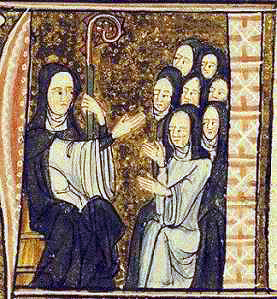
Catholic Saints
Saint Hildegard of Bingen (1098–1179 AD), a German Benedictine abbess, visionary, and polymath, emerged as one of the most extraordinary figures of the medieval Church, blending mysticism, science, and art in a vibrant life that defied the constraints of her era. Born into a noble family in the Rhineland, she entered religious life at a young age, eventually founding monasteries at Rupertsberg and Eibingen, where her leadership and intellect flourished. A Doctor of the Church, Hildegard is renowned for her visionary works like Scivias, which detailed divine revelations through vivid imagery, and her musical compositions, including the Symphonia, a collection of liturgical songs that rank among the earliest known by a named composer. Her scientific treatises explored natural medicine and cosmology, while her correspondence with popes and emperors showcased her influence.
Her feast day is celebrated on September 17.
Doctor of the Church
Born in 1098 AD in the Rhineland, Saint Hildegard of Bingen rose as a visionary abbess, weaving mysticism, music, and science into a legacy that enriched the medieval Church.
Hildegard was born in 1098 AD in Bermersheim, in the Rhineland of the Holy Roman Empire, the tenth child of noble parents Hildebert and Mechtilde. From childhood, she experienced vivid visions—later deemed divine—which shaped her spiritual path. At age eight, her family entrusted her to the care of Jutta von Sponheim, a recluse anchoress at the Benedictine monastery of Disibodenberg, reflecting her status as a tithe to God.
Raised in this enclosed setting, Hildegard learned Latin, Scripture, and music under Jutta’s guidance, absorbing the Benedictine rhythm of prayer and work. Her early years in a region marked by feudal strife and ecclesiastical reform fostered a resilience and curiosity that would later define her multifaceted contributions, nurtured in the quiet of monastic life.
In 1136 AD, Hildegard succeeded Jutta as magistra (leader) of the Disibodenberg nuns, a role she held until founding her own monastery at Rupertsberg in 1150, followed by Eibingen in 1165. Around 1141, at age 42, she received a divine command to record her visions, launching her into prominence with Scivias (Know the Ways), completed in 1151 after a decade of labor.
Her visions, vivid with cosmic imagery—fiery lights, living fountains—gained papal approval from Eugene III at the Synod of Trier (1147–1148), affirming her prophetic voice. As abbess, she led with authority, expanding her community despite resistance from Disibodenberg monks, her leadership blending spiritual insight with practical governance in a male-dominated Church.
Hildegard’s *Symphonia Armonie Celestium Revelationum* (Symphony of the Harmony of Celestial Revelations), a collection of over 70 liturgical chants, stands as one of her most enduring legacies. Composed between the 1140s and 1170s, these monophonic works, with soaring melodies and freeform structures, reflect her visions and rank among the earliest attributable compositions in Western music.
She also wrote Ordo Virtutum, a morality play with music—the oldest surviving example—depicting the soul’s battle with virtues and vices. Performed by her nuns, it showcased her innovative use of music as a theological tool, enhancing worship and earning her posthumous acclaim as a pioneer of medieval sacred song.
Hildegard’s Physica and Causae et Curae, written in the 1150s, explore natural history and holistic medicine, cataloging plants, animals, and remedies based on observation and monastic tradition. Physica details healing properties of herbs, while Causae et Curae links human health to cosmic balance, reflecting her “viriditas” (greening power) concept of divine vitality.
Though not a modern scientist, her works blend empirical knowledge with theology, offering practical cures—like barley for fever—alongside mystical insights. These texts, rare for a medieval woman, highlight her curiosity and influence as a healer, preserving folk wisdom and anticipating later herbalism in a Church often skeptical of such pursuits.
Hildegard’s Liber Vitae Meritorum (1158–1163) and Liber Divinorum Operum (1163–1174) expanded her visionary corpus, addressing morality and cosmology with intricate symbolism. Her extensive correspondence—over 300 letters—with figures like Bernard of Clairvaux, Emperor Frederick Barbarossa, and Pope Anastasius IV, offered counsel and critique, showcasing her boldness in a patriarchal world.
Preaching tours in the 1160s and 1170s along the Rhine, rare for a woman, denounced clerical corruption and rallied reform. Named a Doctor of the Church in 2012 by Pope Benedict XVI, her authoritative voice bridged mysticism and pragmatism, influencing medieval spirituality and earning her the title “Sibyl of the Rhine.”
Hildegard died on September 17, 1179, at Rupertsberg, aged 81, and was buried there, though her relics were lost after the monastery’s destruction in 1632. Her feast day, September 17, honors a life of extraordinary breadth. Canonized in 2012 after centuries of local veneration, she became a Doctor of the Church that year, a rare honor for a woman.
Saint Hildegard of Bingen’s legacy spans theology, music, and science. Her visions inspired mystics, her chants endure in liturgy, and her writings influenced medieval thought, from medicine to cosmology. A visionary ahead of her time, she defied gender norms, leaving a multifaceted heritage that resonates in modern spirituality and scholarship.
“The Word is living, being, spirit, all verdant greening, all creativity. This Word manifests in every creature.”
Born in Bermersheim.
Entered religious life.
Led Disibodenberg nuns.
Became magistra.
Founded Rupertsberg.
Established own community.
Completed visionary work.
Finished Scivias.
Died at Rupertsberg.
Named Doctor of the Church in 2012.

“The Word is living, being, spirit, all verdant greening, all creativity. This Word manifests in every creature.”
Saint Hildegard of Bingen Quotes
“Humanity, take a good look at yourself. Inside, you’ve got heaven and earth, and all of creation.”
“The soul is a breath of living spirit, that with excellent sensitivity, permeates the entire body.”
“All creation is a song of praise to God, echoing the harmony of the divine.”
“The earth is at the same time mother, she is mother of all that is natural, mother of all that is human.”
“God has arranged all things in the world in consideration of everything else.”
“The fire of creation burns in all things, a spark of the divine in every creature.”